Exploring the enigmatic Easter Island and its iconic moai is a bucket-list experience for many. The Easter Island Moai Archaeology Tour promises a captivating journey through the island’s rich history and cultural significance. Led by expert guides, you will discover the legendary Ahu Akivi, Ahu Tahai, and Puna Pau Quarry, uncovering the advanced engineering techniques behind the moai’s construction. With stunning views of the Pacific and fascinating insights into the ancestral spirits of the Rapa Nui people, this tour offers an enriching experience for history enthusiasts and nature lovers alike. But what secrets do these ancient sites hold, waiting to be unveiled?
Good To Know
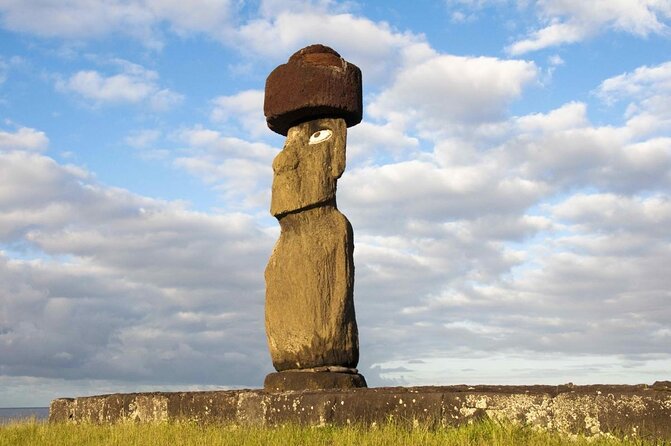
- This half-day tour explores the famous moai sculptures of Rapa Nui National Park, including Ahu Akivi, Ahu Tahai, and Puna Pau Quarry.
- The tour is led by an expert guide and includes round-trip hotel transportation, with an entrance fee of around $80 to the national park.
- The moai represent the spirits of ancestors and high-ranking tribe members, showcasing the advanced engineering and artistry of the Rapa Nui people.
- The Puna Pau Quarry is a notable site for producing red scoria pukao (topknots) and offers panoramic views of the surrounding landscape.
- The tour provides an enriching experience, allowing visitors to explore the captivating narrative and mysteries of Easter Island’s cultural heritage.
It's also worth checking out some other tours and experiences nearby.
Tour Overview
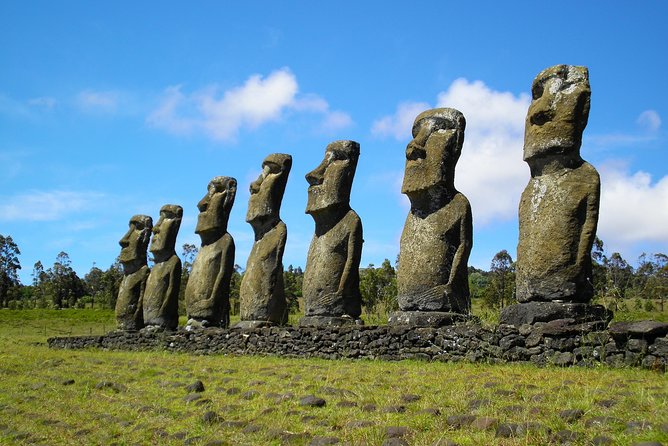
What’s the Easter Island Moai Archaeology Tour?
It’s a half-day excursion in Rapa Nui National Park, where you’ll explore the island’s famous moai stone sculptures with an expert guide.
The tour visits key sites like Ahu Akivi, Ahu Tahai, and Puna Pau Quarry. Located in Hanga Roa, Chile, the tour lasts around 3 hours and starts at 3:00 PM.
Round-trip transport from your hotel is included.
You’ll learn about the archaeological significance of these iconic statues and gain insights into Rapa Nui’s rich history and culture during the guided exploration.
Inclusions and Costs
The Easter Island Moai Archaeology Tour includes a professional guide, round-trip hotel pickup and drop-off, and transport by air-conditioned van or bus.
However, the tour doesn’t cover the entrance fee to Rapa Nui National Park, which costs 56,000 Chilean pesos (around $80). Gratuities, food, and drinks are also not included.
The tour price starts at $82 and varies based on group size. Travelers can cancel their booking for free up to 24 hours before the tour starts.
Significance of Rapa Nui
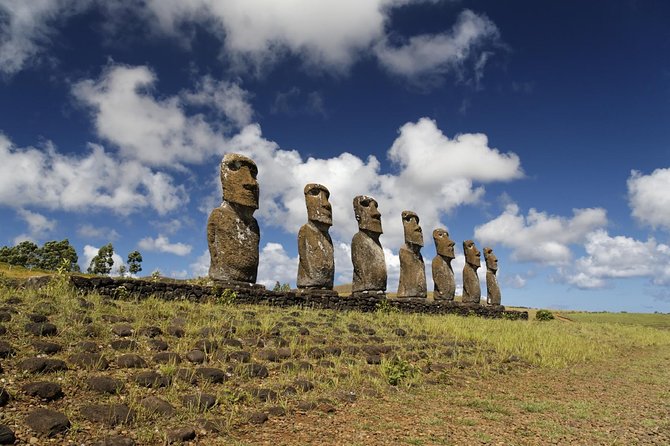
Rapa Nui National Park, a UNESCO World Heritage site, boasts an astonishing collection of around 900 moai and 300 ahu (ceremonial platforms).
These iconic stone statues represent the spirits of ancestors and high-ranking tribe members, sculpted from volcanic ash. The archaeological significance of Rapa Nui is remarkable:
- The moai feature unique characteristics, with some displaying pukao (topknots) made from red scoria near the Puna Pau quarry.
- The intricate stonework and placement of these ancient structures continue to captivate and puzzle historians and archaeologists.
- Ahu Vinapu and Ahu Riata showcase the island’s sophisticated engineering and construction techniques.
- Ahu Akivi‘s seven moai facing the ocean are a notable exception, differing from the traditional inward-facing statues.
Moai: Ancestral Spirits
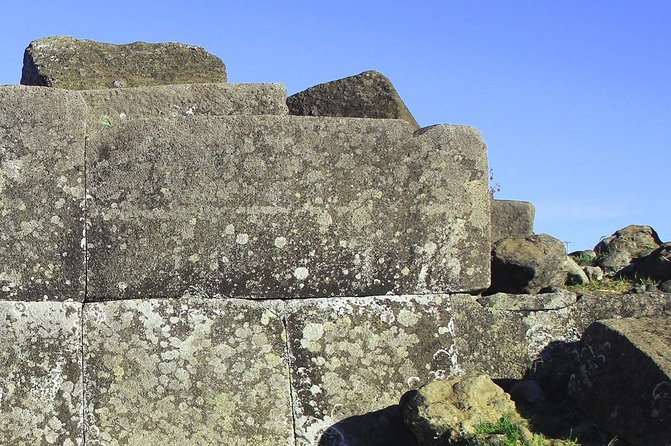
These massive stone figures, known as moai, were carved to represent the spirits of the island’s ancestors and high-ranking tribal members. They were believed to watch over the people and protect the island.
The moai stand tall, with elongated heads, heavy brows, and distinctive features. Their creation was a remarkable feat of engineering and artistry, demonstrating the advanced skills of the Rapa Nui people.
From the smooth, chiseled surfaces to the intricate details, each moai is a testament to the cultural and spiritual significance of these enigmatic monumental sculptures.
Visitors can marvel at the moai’s enduring presence and ponder the mysteries they hold.
Puna Pau Quarry
One of the most notable quarry sites on Easter Island is Puna Pau, located near the moai statues. This site is known for its production of the distinct red scoria pukao, or topknots, that adorned many of the island’s iconic figures.
Approximately 30 pukao can be found near the quarry, offering a glimpse into the intricate sculpting processes used by the Rapa Nui people.
The quarry features:
- Remnants of abandoned pukao in various stages of completion
- Unique geological formations and colors in the volcanic rock
- Evidence of tool marks and carving techniques
- Panoramic views of the surrounding landscape and coastline
Guided Exploration
The guided tour provides insightful commentary on the history and culture of Rapa Nui from the knowledgeable guides.
Visitors explore the sacred sites, learning about the island’s ancient people and the mysteries surrounding the iconic moai. The guides share their expertise, offering ample time for photos and appreciating the stunning ocean views and impressive ancient masonry.
At Hanga Piko, the group observes a ceremonial moai with perplexing stonework, adding to the fascination of the archeological wonders.
The guided exploration offers an enriching experience, allowing travelers to explore the captivating narrative of Easter Island’s past.
Scenic Highlights
Along With the guided exploration, the Easter Island Moai Archaeology Tour offers visitors a chance to appreciate the island’s stunning natural scenery.
As you trek through the Rapa Nui National Park, you’ll be treated to captivating ocean vistas and ancient volcanic landscapes.
The tour highlights include:
- Panoramic views of the Pacific Ocean from the elevated moai platforms
- Dramatic cliffs and rocky shores that frame the mysterious stone figures
- Sweeping vistas of the island’s lush, rolling hills and valleys
- The striking red scoria quarry of Puna Pau, where the moai topknots were sourced
These scenic highlights provide a breathtaking backdrop to the archaeological wonders, offering a truly immersive experience on Easter Island.
Reviews and Recommendations
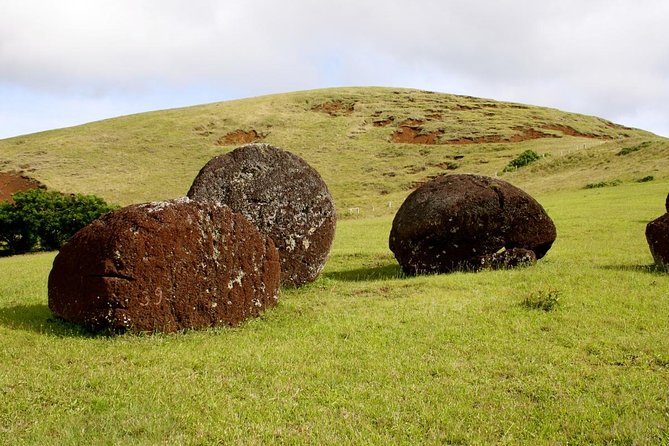
Travelers have largely praised the Easter Island Moai Archaeology Tour, awarding it an impressive 4.5-star rating from 23 reviews.
Guides were consistently lauded for their friendliness, extensive knowledge, and allowing ample time for photos.
However, a few reviewers noted occasional issues with guide friendliness and translation difficulties for English speakers.
While many expressed a desire for a longer tour experience, the excursion was generally deemed ideal for those with limited time on the island.
Here's a few more nearby tours and experiences we think you'll like.
Frequently Asked Questions
Can I Combine This Tour With Other Activities on Easter Island?
Yes, you can combine this tour with other activities on Easter Island. There are plenty of options, like hiking, visiting volcanic caves, or exploring the island’s coastal landscapes. Just be sure to plan your time wisely.
Are There Any Age Restrictions or Requirements for This Tour?
The Easter Island Moai Archaeology Tour doesn’t have any age restrictions. It’s suitable for all ages, though young children may require extra supervision. The tour is an engaging way to explore the island’s unique archaeological sites.
What Is the Best Time of Year to Visit and See the Moai?
The best time to visit Easter Island and see the moai is during the dry season, from May to October. The weather’s mild, and you’ll avoid the island’s rainier months.
How Much Time Do Visitors Typically Spend Exploring the Archaeological Sites?
Visitors typically spend around 3 hours exploring the archaeological sites on the Easter Island tour. The tour provides ample time to visit the key moai landmarks and learn about the island’s rich history from the expert guide.
Are There Any Unique Souvenirs or Local Crafts Available for Purchase?
Visitors can find unique Easter Island souvenirs like handcrafted wooden moai figurines, woven baskets, and locally-produced crafts at shops in Hanga Roa’s town center. These make excellent mementos of the island’s rich cultural heritage.
Not for you? Here's more of our most recent tour reviews happening neaby
- Small Group (8 PAX) / Cruise Ships Tours at Easter Island
- Easter Island: Private North & West Highlights Tour
- Easter Island: Birdman Cult Private Tour
- Ahu Vinapu, Rano Kao and Orongo City Half-Day Tour
- Easter Island: Half-Day Archaeology Tour
- Sunrise Tongariki: Sunrise at Tongariki Park Private Tour
- Easter Island: Highlights Private Tour
- Easter Island: Full-Day Tour to Anakena
- Rapa Nui Highlights Program: 3 Incredible Tours to Discover!
- Volcanic Refuges: Excursion to Underground Civilization
- Ancestral Fishing: Fishing With an Experienced Rapa Nui
- 2 Half Days & 2 Full Days Private Tours | OPTION B
- Mataveri Airport: Private Transfer IN Hotel
- Airport Transfer
- Full Day Private Tour: Factory of the Moai the Stone Giants
The Sum Up
The Easter Island Moai Archaeology Tour offers an immersive experience for history enthusiasts and nature lovers. Led by expert guides, you’ll uncover the rich cultural significance of the iconic moai and witness the stunning natural landscapes of Rapa Nui. From the Ahu Akivi site to the Puna Pau Quarry, this tour provides a deep dive into the island’s captivating archaeology and engineering marvels.
